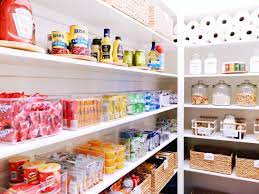Give “Editing” Your Home A Try With These Helpful Tips From ’The Home Edit’

------ What Is ‘The Home Edit’? ------
The Home Edit team swears by four concrete steps in their organizing process: edit, categorize, contain, and maintain. And there's a very obvious reason that the “edit” portion is first—it's what sets the foundation for any space that's transitioning into a more organized one.
------ Tips For Organizing (For Beginners) ------
**Start Small (And be sure to…. That’s Right: EDIT)
The biggest mistake people make when organizing their home is trying to purge and organize simultaneously. Clea and Joanna refer to this as a blackbelt level, do-not-try-this-at-home technique. It’s imperative that you free up space and remove clutter prior to organizing. Tackle specific, smaller areas one at a time, like a drawer or cabinet. “It’s easier for your mental bandwidth,” Clea says. Whether that means going through oils that are leaking in the kitchen, toys that are broken in the playroom, puzzles with missing pieces, etc., these are the items that are easy to get rid of right off the bat. One caution that Clea and Joanna say is to never attempt at an entire room at once. Start with the easiest spaces (ex. A drawer) and move up to the hardest ones (ex. A pantry). “You should always tackle one space from start to finish before moving onto the next,” Joanna says. Always aim to keep your home only 80% full.
**Categorize
Once you’ve gotten rid of the items you no longer need, the next step is to categorize everything. Lay it all out and begin to group items into specific categories. Place items from each category into their own specific containers, and LABEL LABEL LABEL. “Labels are like the police–they demand you to abide,” Clea says. If you’re organizing your bathroom, separate lotions, toners, dental care, hair products/tools, and so on. These categories will serve as a roadmap for how you actually organize them within drawers and cabinets.
**Contain Items
The way that you contain your items can make or break the functionality of a space. Whether you’re dealing with pasta or shoes, this will determine how things fit within a space. While you may be asking yourself, “If my chips are already in a bag, why would I remove and relocate them?” the answer is fairly simple. By using containers that are designed to fit together, you are taking full advantage of the space in your pantry, eliminating the need to play food Tetris with flimsy or oddly-shaped items. You can then label specific containers so that you can continue to refill them with the same items. Plus, you’ll never reach the Khloe Kardashian-level pantry aesthetic with unattractive boxes and bags.
**Focus on The Room You’re Working On:
Think about HOW THE ROOM IS USED, NOT WHAT THE ROOM IS
Instead of approaching a room based on what you call it (ex. Laundry room), focus on the room’s actual use. Yes, a laundry room is for laundry, but it can also be a utility room. “Think of the ways the room operates beyond its central purpose,” Clea and Joanna explain. Once you do that, you’ll create much more opportunity for organization, which works especially well when you have rooms that are more spacious than others.
A family room can also be a playroom or an office, and you can keep that space more functional and organized by setting up zones and systems to simplify how you use it. Whether that means putting toys in a basket under the TV or office supplies in a credenza, you’re assigning specific items to specific storage spaces within the room where they're used.
------ Follow The Rainbow ------
The Home Edit’s rainbow method sorts belongings by color, particularly the colors present in the rainbow. (That’s red, orange, yellow, green, blue, indigo, and violet, otherwise known as ROYGBIV!)
Although they don't force their love of rainbow on their clients every time, they are passionate about color order in specific parts of the home. "In a playroom, it's extremely helpful," Clea said. "It's very intuitive for kids, so for children and their rooms specifically, it is a really smart way for them to learn where things go and where to find what they're looking for.”
There are definitely people — either for aesthetic purposes or because they just can't wrap their head around it — who are not rainbow candidates, and that is totally fine. We do not push our rainbow ways onto people!" Clea said. "There are a lot of people whose aesthetic is natural woods, or a black and white situation. Everyone is different, after all.
Give it a try with things like books, toys, clothing, the fridge or pantry, and decor on shelves around your house!

